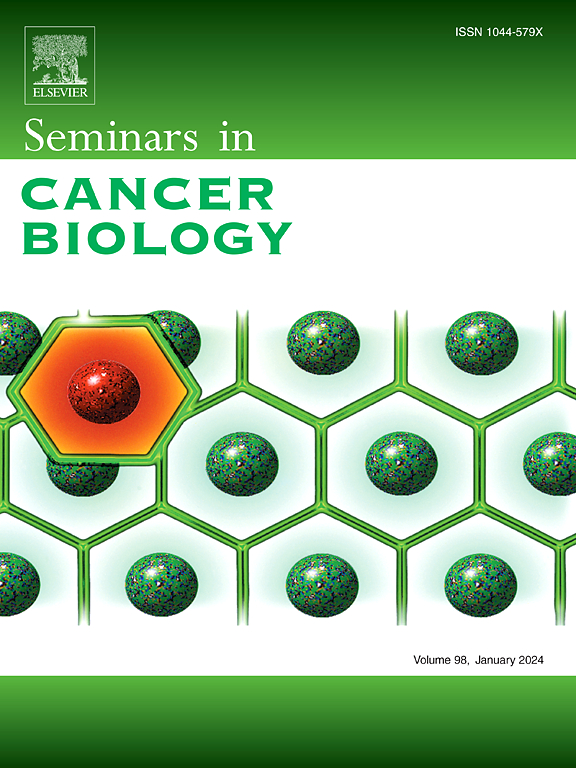导管内乳头状粘液瘤进展为胰腺癌的多组学标志物。
IF 12.1
1区 医学
Q1 ONCOLOGY
引用次数: 0
摘要
胰腺导管腺癌(Pancreatic ductal adenocarcinoma, PDAC)是最常见、最致命的一种胰腺癌,它没有特定的症状,大多数患者在疾病已经发展到晚期时才被诊断出来。化疗通常只有适度的效果,使手术成为最有效的治疗选择。然而,只有一小部分患者可以接受手术。减少与PDAC相关的死亡负担的一个可行策略是关注前驱病变并确定能够预测谁将演变为PDAC的标志物。虽然大多数pacs被认为是由胰腺上皮内肿瘤(PanINs)引起的,但5-10%的pacs是由导管内乳头状粘液瘤(IPMNs)引起的,IPMNs是一种团块形成的囊性病变,在一般人群中非常常见。IPMNs为研究人员分析胰腺癌的发生提供了一个宝贵的模型,也为临床医生早期检测PDAC提供了一个目标人群。IPMN向癌症的演变是一个复杂的多步骤过程,因此单个标记的识别将不是解决方案。近年来,多种组学技术已被用于鉴定IPMN进展和癌变的可能生物标志物。唯一可预见的策略将是使用标准流行病学工具或人工智能将多组学数据与临床和形态学特征整合到进展评分或特征中。本文的目的是回顾遗传生物标志物的现有知识,并简要介绍其他组学,如代谢组学,暴露组学,miRNome和ipmn的表观基因组学。本文章由计算机程序翻译,如有差异,请以英文原文为准。
Multi-omic markers of intraductal papillary mucinous neoplasms progression into pancreatic cancer
Pancreatic ductal adenocarcinoma (PDAC) is the most lethal and common form of pancreatic cancer, it has no specific symptoms, and most of the patients are diagnosed when the disease is already at an advanced stage. Chemotherapy typically has only a modest effect, making surgery the most effective treatment option. However, only a small percentage of patients are amenable to surgery. One viable strategy to reduce PDAC death burden associated with the disease is to focus on precursor lesions and identify markers able to predict who will evolve into PDAC. While most PDACs are believed to be preceded by pancreatic intraepithelial neoplasms (PanINs), 5–10 % arise from Intraductal papillary mucinous neoplasms (IPMNs), which are mass-forming cystic lesions that are very common in the general population. IPMNs offer an invaluable model of pancreatic carcinogenesis for researchers to analyse, as well as a target population for PDAC early detection by clinicians. The evolution of IPMN into cancer is a complex and multistep process, therefore the identification of individual markers will not be the solution. In recent years, multiple omics technologies have been instrumental to identify possible biomarkers of IPMN progression and carcinogenesis. The only foreseeable strategy will be to integrate multi-omics data, alongside clinical and morphological features, into a progression score or signature using either standard epidemiologic tools or artificial intelligence. The aim of this manuscript is to review the current knowledge on genetic biomarkers and to briefly mention also additional omics, such as metabolomics, the exposome, the miRNome and epigenomics of IPMNs.
求助全文
通过发布文献求助,成功后即可免费获取论文全文。
去求助
来源期刊

Seminars in cancer biology
医学-肿瘤学
CiteScore
26.80
自引率
4.10%
发文量
347
审稿时长
15.1 weeks
期刊介绍:
Seminars in Cancer Biology (YSCBI) is a specialized review journal that focuses on the field of molecular oncology. Its primary objective is to keep scientists up-to-date with the latest developments in this field.
The journal adopts a thematic approach, dedicating each issue to an important topic of interest to cancer biologists. These topics cover a range of research areas, including the underlying genetic and molecular causes of cellular transformation and cancer, as well as the molecular basis of potential therapies.
To ensure the highest quality and expertise, every issue is supervised by a guest editor or editors who are internationally recognized experts in the respective field. Each issue features approximately eight to twelve authoritative invited reviews that cover various aspects of the chosen subject area.
The ultimate goal of each issue of YSCBI is to offer a cohesive, easily comprehensible, and engaging overview of the selected topic. The journal strives to provide scientists with a coordinated and lively examination of the latest developments in the field of molecular oncology.
 求助内容:
求助内容: 应助结果提醒方式:
应助结果提醒方式:


